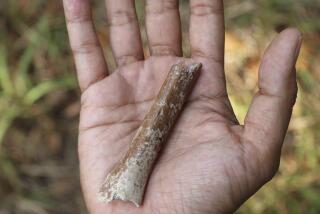DNA tests confirm a previously unknown hominid species
- Share via
After sequencing the DNA from a 30,000-year-old pinkie finger discovered in a Siberian cave, researchers have confirmed that it belonged to a previously unknown hominid species that probably diverged from the Neanderthal line about 350,000 years ago.
The genetic sequence shares as much as 6% of its segments with modern-day Melanesians in the South Pacific, suggesting that the extinct species — which has no formal name but whose members are being called Denisovans because the bone was found in the Denisova Cave — ranged widely throughout East Asia.
In May, researchers showed that modern humans of European descent carry 2% to 3% Neanderthal DNA, suggesting that there was interbreeding between the two groups tens of thousands of years ago.
The new genetic data indicate that a sister group to the Neanderthals migrated east while the Neanderthals moved west and that they interbred with the humans who ultimately settled in the South Pacific, said anthropologist Henry Harpending of the University of Utah, who was not involved in the new research.
“We had a number of hints that there was something else in Melanesian genome, an admixture from some other group,” he said. “To discover that it was from this particular group suggests that it was pretty widespread in Asia.”
The new hominid was first identified in March on the basis of mitochondrial DNA extracted from the pinkie bone, which was excavated in 2008 by Russian researchers. The nuclear DNA sequence, reported this week in the journal Nature by the same international team, provides much more information. It marks the first time that a new hominid has been identified solely on the basis of DNA.
The team also has a tooth from the site that has matching mitochondrial DNA. The tooth is relatively primitive in appearance. Beyond that, they have no information about what the Denisovans looked like. It is quite possible, researchers said, that fossils from another site will eventually give a more complete picture of their appearance, particularly if the tooth can be matched to a skull elsewhere.
Most fossils are found in equatorial regions, where heat and humidity combine to degrade DNA rapidly. But researchers have been finding intact DNA in caves in Europe and Asia, where cold weather and higher altitudes preserve it much more effectively.
A team led by Johannes Krause and Svante Paabo of the Max Planck Institute for Evolutionary Anthropology in Leipzig, Germany, have been developing techniques for sequencing ancient DNA. The team was responsible for sequencing the nuclear DNA of a Neanderthal, as well as the mitochondrial DNA from the Denisovan pinkie.
The pinkie itself is from a girl about 5 to 7 years old. Comparing the finished genetic sequence to that of Neanderthals, the team concluded that the two lineages branched off from a common ancestor about 350,000 years ago. (Humans and Neanderthals shared a common ancestor 600,000 years ago.)
The researchers then compared the Denisova genome to those from people from South Africa, Nigeria, France and Papua New Guinea. The only overlap was with the New Guinea DNA. To double check, they analyzed seven more people, including another person from New Guinea and one from nearby Bougainville. Again, the only overlap was with the Melanesian DNA.
“The orthodoxy for the past 10 to 20 years has been that all humans descended from a speciation event in East Africa,” Harpending said. “That’s mostly still true.”
But the dogma that modern humans never mixed with other hominids after they left Africa has been challenged twice, he said. “The past is looking more interesting than it did a few years ago.”
More to Read
Sign up for Essential California
The most important California stories and recommendations in your inbox every morning.
You may occasionally receive promotional content from the Los Angeles Times.










